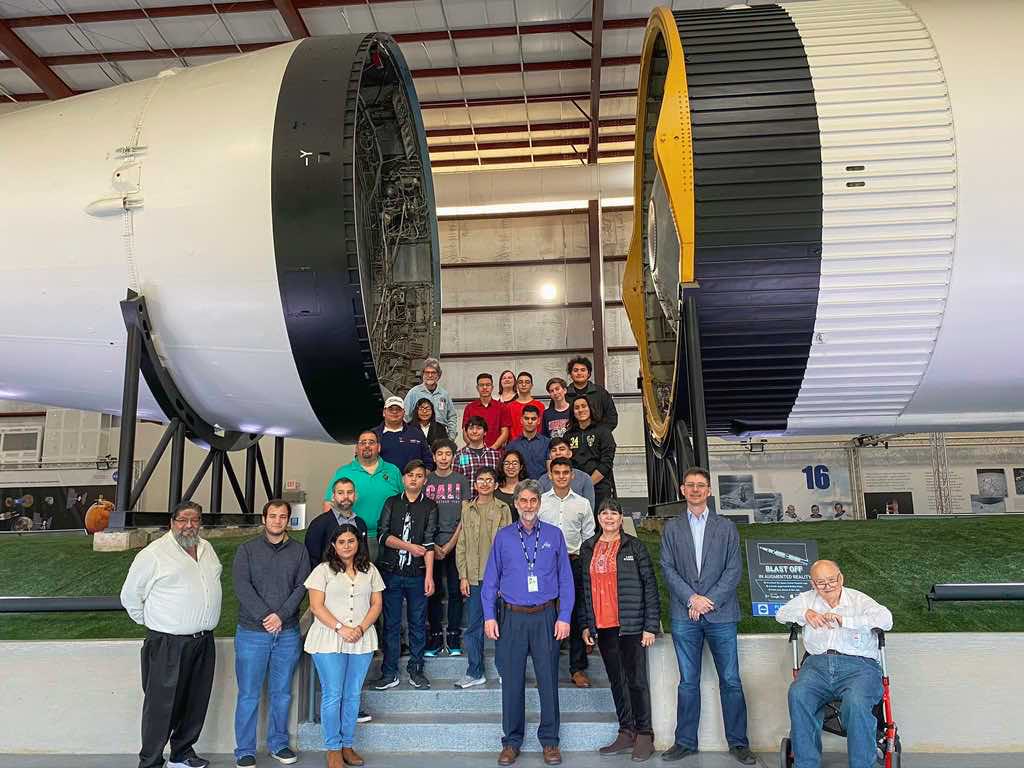SPACE SETTLEMENT DESIGN TOURNAMENT (SSDT)
When: 2024 Dates TBA
How do you build a lunar mining settlement? what does it take to build an outpost on mars?
If these questions interest you, you might be interested in a one-of-a-kind experience available now to high school students in South Texas.
The Space Settlement Design Tournament invites high school students to learn the nitty-gritty of conceptualizing, planning, and pitching plans for future space exploration. The tournament, modeled on and developed in conjunction with the internationally famous Space Settlement Design Competition®, offers students unique insight and expertise into one of the fastest-growing industries in the world, commercial space. It is the only sanctioned tournament of its kind in South Texas.


How It Works
Participating students are divided into four teams, each of which is led by a working professional in the space industry who serves as “CEO.” The teams collaborate to develop business plans for companies as though they were competing for a space settlement request for proposal (RFP). Over four days, each team works furiously to prepare detailed proposals, which they present to a panel of judges, including current and former NASA executives involved with the agency’s engineering and technology transfer operations. The judges then select the winning proposal.
“I wasn’t entirely sure what a career in the space field was. I didn’t know how a sociology major could get into space. I hadn’t been exposed to how you communicate with people with other skills. The tournament was the closest I could get to touching the surface of what my career could look like. The space industry is a very blank page. All we have figured out is how to write our name and the date. We have complete freedom to write whatever else is on that page. The problems of space are still being discovered, and the answers still need answering.”
About the Facilitators

Anita Gale
Anita Gale is a Senior Project Engineer in Space Shuttle Payload & Cargo Integration for The Boeing Company in Houston. In her career she has worked on the Space Shuttle, providing conceptual designs for cargo integration on future launch vehicles, R&D for Shuttle upgrades and future missions of both reusable and expendable launch vehicles, and process improvements. She holds three US patents on launch vehicle payload interface standardization and containerization, which are essential technologies for reducing future vehicle processing costs and schedules. In 1984, Anita co-founded the Space Settlement Design Competition (SSDC), an industry simulation that engages high school students in designing future space settlements.
Hear From Some of the Students Who Participated in Spring 2021!
Frequently Asked Questions
Any Rio Grande Valley high school student interested in learning about NewSpace.
No, if you have a desire to learn and can collaboratively work in a team then this may just be the competition for you. If you are interested in the space industry, we are interested in you.
Previous participants report that skills they learned during the SSDT proved valuable in the short and long term career journey. Many credit the tournament with having helped them with their leadership development and/or ability to work in teams. Others say that the glimpse they got into the space economy through the tournament influenced their career plans. Some are now working for space companies.
Participants get randomly placed on teams, so in all likelihood you won’t be only with students from your school.
Depends on each person’s interests and skills. Each student gets placed on a team, and each team forms a “company” with a proper management structure and smaller working groups.
Once the teams have been put together the team members then elect their President, Vice President, and other managers for the various different sections that are covered by the RFP. Once that selection process is done then each group must dissect their part of the RFP and assign tasks. Some will research, some will draw, and others will focus on ideation.
The final product is the culmination of all of the slides put together into a cohesive presentation that will be presented and sold to the judges. speakers will present their product to Red Team advisors, who will give them ideas, critiques, and ask questions according to the requirement of the RFP. Generally this is done the day before the final presentation.
The settlement must be built according to the RFP specifications based on the type of facility required for that year’s competition. During the creation stage, a Pink and or Red Team advisory group will review a presentation as it is presented to them and ask questions and give advice. The students then get to work on these suggestions in order to better complete their proposal. This can be a two-part process, where the group meets with the Pink Team group on day one and with the Red Team on day two. On the final day, teams present their proposal to the judges. The team with the most creative and complete proposal which sticks to the RFP is generally the winner. The judging also is dependent on other specifics, such as turning in the proposal on time and sticking within the maximum number of slides allowed. The actual way a team presents the proposal may be taken into account and may even be the deciding factor.
Generally, 4 days. Thursday evening is a meet and greet, as well as team setup. The teams then gather and select their officers so that they can be ready for Friday morning. This is also when the teams get to meet and speak to their CEO. Saturday is spent putting together their proposal. Lastly, on Sunday, the teams present in front if a panel of judges. Little sleep during this competition is quite common. It requires intense focus and a lot of work to complete each part of the proposal. The only time the students will see other groups’ presentations is on the last day when each presents before the judges. Each groups’ information is kept private until the presentation.

